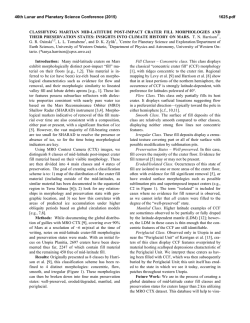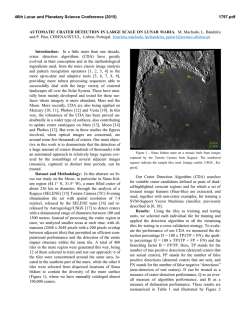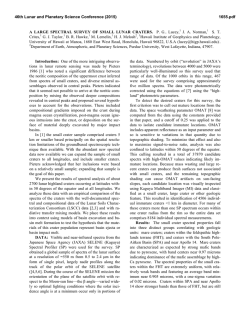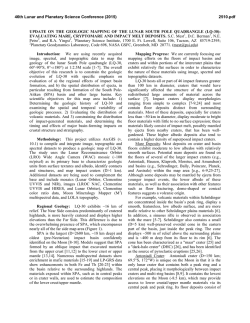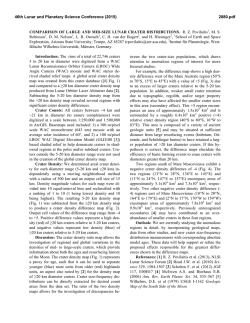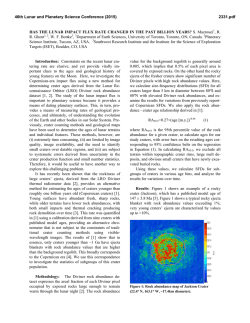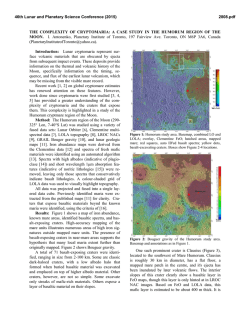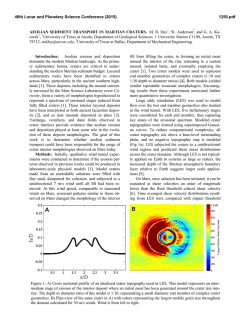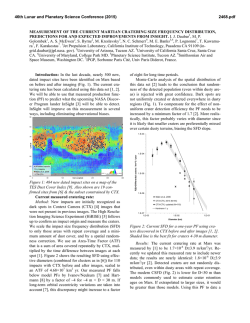
TARGET PROPERTY CONTROLS ON MARTIAN IMPACT CRATER
46th Lunar and Planetary Science Conference (2015) 1046.pdf TARGET PROPERTY CONTROLS ON MARTIAN IMPACT CRATER MORPHOLOGIES. B.M. Hynek1-2 and R.R. Herrick3, 1Laboratory for Atmospheric and Space Physics, University of Colorado-Boulder, 3665 Discover Drive, Boulder, CO 80303, 2Dept. of Geological Sciences, University of Colorado-Boulder, 3Geophysical Institute, University of Alaska, 903 Koyukuk Drive, Fairbanks, AK 99775 [email protected] lar/periglacial process and limiting our findings to lowIntroduction: Impact cratering is the most ubiquimid latitudes. The following are major trends identitous geologic process across the solar system and the fied in our study. resulting craters provide inferences into target and Simple vs. complex: Pristine simple craters of this impactor properties. Yet separating the varied contrisize range are preferentially found in the northern butions of target and impactor to final crater form is a plains and on volcanic terrains (Tharsis and Elysium). formidable task. Here, we explore effects of Martian Thus, we infer that simple craters in the 7-9 km diametarget properties on the cratering process using a globter range formed on terrains that are rheologically al crater database and recent geologic map. In a comstrong and relatively homogenous to a depth of at least panion abstract [1], we characterize impactor influ1 km. Simple craters have somewhat of a spatial antiences on final crater form. correlation with complex craters, which are distributed Hypothesis, Data Sets, and Methods: Our hythroughout the southern highlands. We hypothesize pothesis is that a planet’s target properties influence that heterogeneities in the crust and local topography final crater form. We tested this hypothesis by conled to the varied complex crater forms. Complex craducting a global examination of Martian impact craters ters of all classes are well-distributed, but types (flat from [2] compared with geological units defined by [3] floored vs. central peak vs. central pit) are geographand our own assessment of fine scale geologic relaically bound, in general. tions and units, following up on an initial study in [4]. Central pit craters: Central pit craters have a charThe effects of target properties during the impact proacteristic depression in their centroids and exist on cess, including the strength of crust, layering, and volMars, Mercury, Ganymede, and Callisto. Numerous atile content (among other factors), have previously hypotheses have been put forth to explain central pit been studied through geologic studies, modeling, and formation including subsurface volatiles, layered crust, experiments [e.g. 5-7]. Here, we take a new approach or internal volcanic processes [e.g., 5,8]. We find that We started with the assumption that craters of a Martian central pit craters are anti-correlated with cengiven diameter had roughly the same impact energy tral peak craters. Additional, they are most abundant and differences in crater form would be a result of in volcanic terrains around major constructs (Tharsis, either impactor or target properties. We studied craters Syrtis, Elysium, and Hesperia). In fact, 48% of our with 7-9 km diameters, within the simple-complex central pit sample occur in volcanic units delineated by transition range on Mars, in order to maximize crater [3], while these volcanic terrains only represent 16% variation for a near-constant impact energy. We seof the total surface area of Mars (Fig. 1). On the other lected all pristine craters on Mars (degradation state = hand, central peak craters are mostly absent from vol4) from the crater database of [2] (n = 574 craters) in canic terrains, but do occur around the fringes (where an effort to minimize post-formation modification units are presumably thin). Our interpretation is that from erosion, etc. We used the existing classification of craters in this database that included simple, complex-central peak, complex-central pit, complex-summit pit, complex-flatfloored, and complex-unclassified. These were ingested into a GIS environment for comparison to the geologic map of [3] to assess geologic unit controls on crater form. Results and Interpretations: We found that the local geology has a strong influence on crater form, although in some regions there is only a minor influence. Few pristine craters exist at latitudes above ±45°; likely due to po- Figure 1. Distribution of 7-9 km pristine central pit craters (blue dots) from [2]. Red areas are vast plains composed of flood basalts [3]. 46th Lunar and Planetary Science Conference (2015) the central pit craters in this size range occur from excavation in a layered target, perhaps layered basalt flows interspersed with weak tephra layers. The flat floor represents a hard layer, just underneath a weak layer, at the base of a nonparabolic transient cavity, with the central pit representing some minimal penetration into the hard layer (the "sombrero" model for excavation in a layered target). Our findings are not supportive of the subsurface volatile hypothesis [e.g. 8]. Flat-floored craters: This class of craters also has some spatial associations with geologic terrains and central pit craters. Roughly half are found in volcanic terrains, with the rest being in Isidis basin and along the lowland-highland transitional terrains, with a few peppered throughout the highlands. Close examination of these craters with CTX data show a significant fraction are flat-floored due to post-impact modification indicating that fewer craters form with flat floors than implied from “pristine” craters in the database. Case study: Nepenthes region W-SW of Elysium: Fig. 2 shows a region of Mars with clear influence of target properties on resultant crater form. Represented are the pristine 7-9 km diameter craters from [2] on the geologic map and unit symbols of [3]. This area represents a transect from the northern lowlands, through the transition terrains, into southern highlands units. We confirmed that indeed the geologic units are properly mapped at the fine scale we used for our local investigations of the geology around these craters. A few craters were reclassified by type and those not appearing pristine in CTX images were removed. The northern plains materials representing layered sediments/ volcanics and volatile-rich fractured ground are covered almost exclusively by simple craters. A thick sequence of wet, fine sediments [9] that later consolidate could result in deep [10] simple craters. While clear evidence for a volatile-rich crust exist, central pits are absent. Central pits are instead found on the lava units in the central and southwest regions (tan and purple colors, respectively) of the map. The rough highlands terrains host most of the central peak craters and here and globally this class is mostly found on topographically rugged terrains of heterogeneouslymixed materials (e.g., impact ejecta, volcanics, sediments) and the transitional terrains (dark tan). Conclusions: We used a diameter slice of pristine craters on Mars to test the importance of target properties on final crater form. The narrow range of diameters ensures a consistent impact energy and thus differences in form are in part a result of target properties. We found that particular classes of craters are correlated spatially and also with different geological terrains. Simple craters of this size range are found primarily in 1046.pdf the layered northern plains and on layered lava flows. Central pit craters have an affinity for volcanic terrains and we infer weak (tephra?) layers interbedded in the lavas could explain the central pits. Central peak craters populate the rough highlands terrains and are lacking in smooth volcanic plains. This research suggests that target properties can exhibit strong control on the morphometry of the resultant crater. References: [1] Herrick R.R. and B.M. Hynek (2015) LPSC VL (this meeting). [2] Robbins S.J. and B.M. Hynek (2012a) JGR, 117, E05004. [3] Tanaka K.L. et al. (2014) USGS, 3292. [4] Herrick, R.R. (2012) LPSC XLIII, 2380. [5] Barlow, N.G. (1990) Icarus, 87, 156-179. [6] Collins G.S. et al. (2008) MAPS, 43, 1955-1978. [7] Robbins S.J. and B.M. Hynek (2012b) JGR, 117, E06001. [8] Hale, W.S. (1982) LPSC XIII, 295-296. [9] Cook, M. et al. (2011) JGR, 116, E09003. [10] Boyce, J.M. et al. (2006) GRL, 33, L06202. Figure 2. Nepenthes study region. Geologic units are from [3] and type of pristine 7-9-km-diameter craters are from [2]. In this region of Mars, clear spatial correlations exist between crater type and the local geology.
© Copyright 2026

